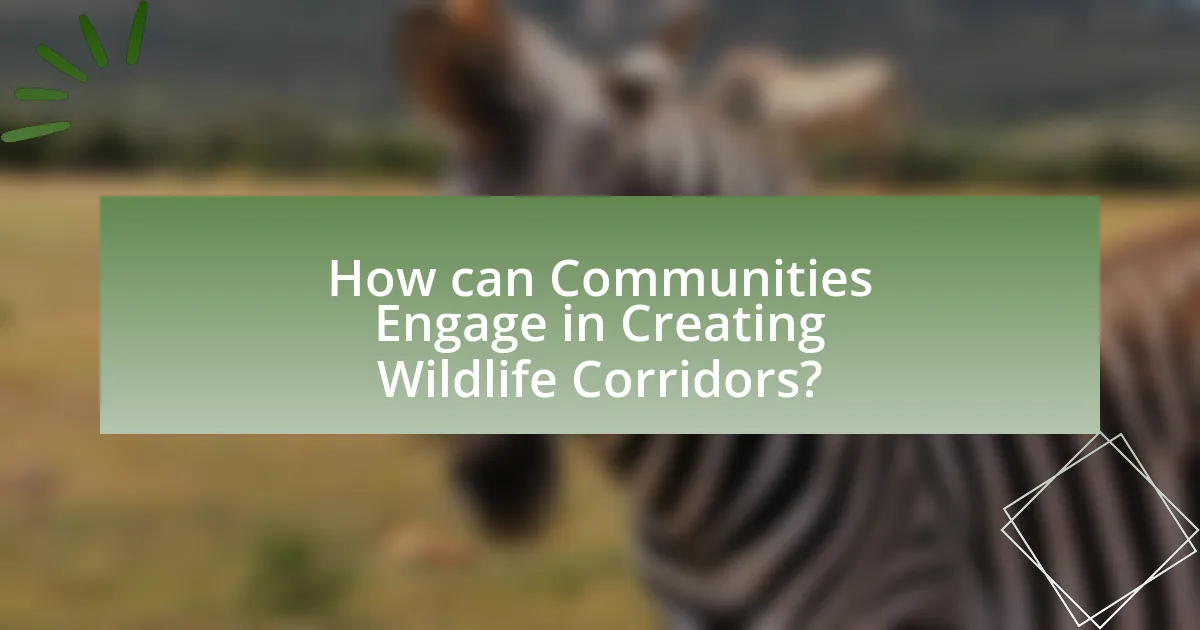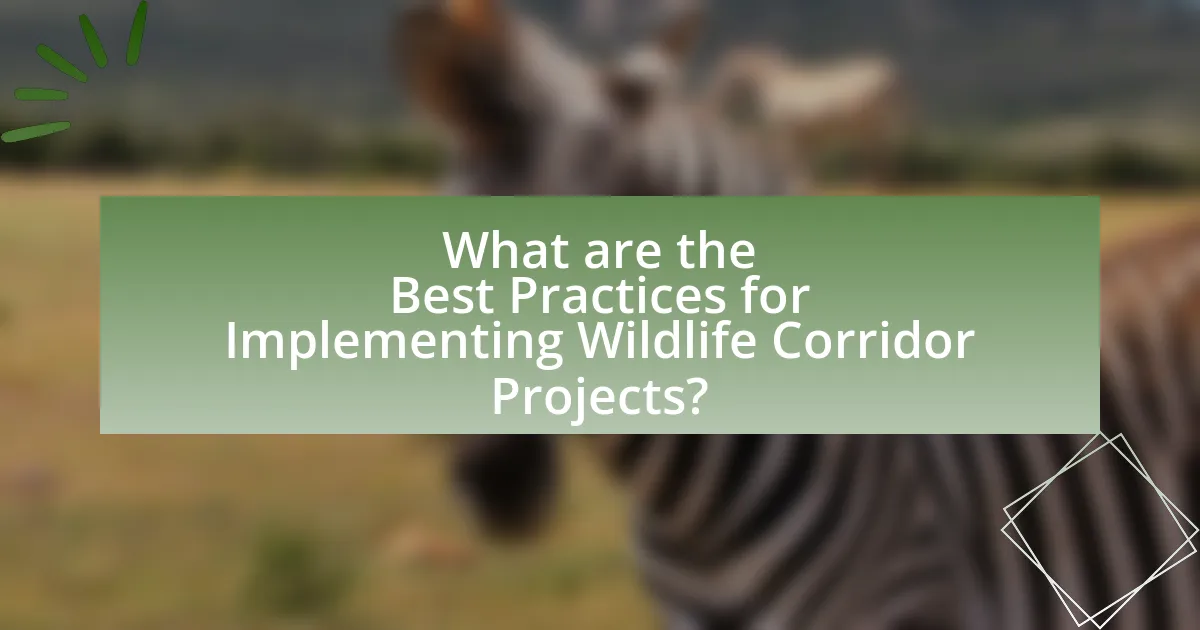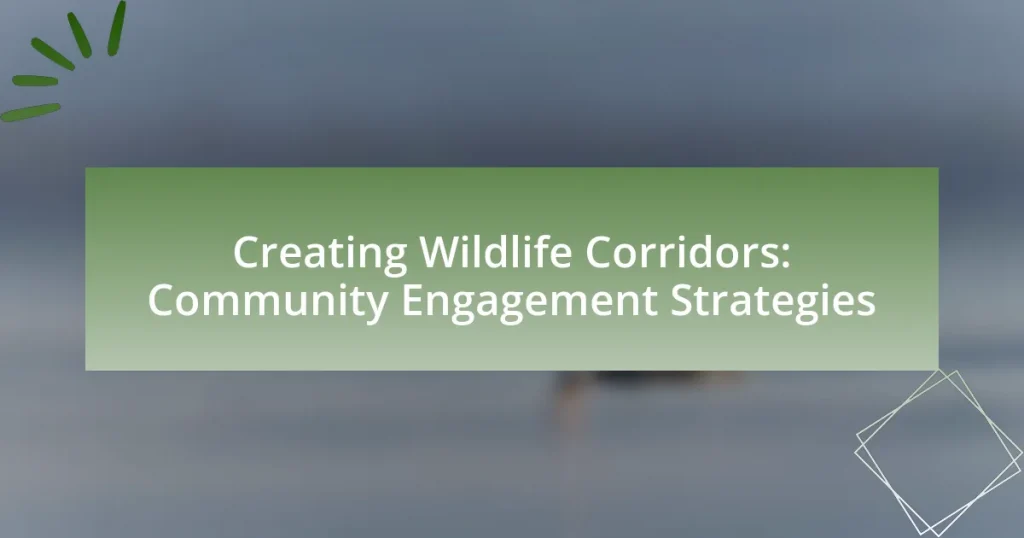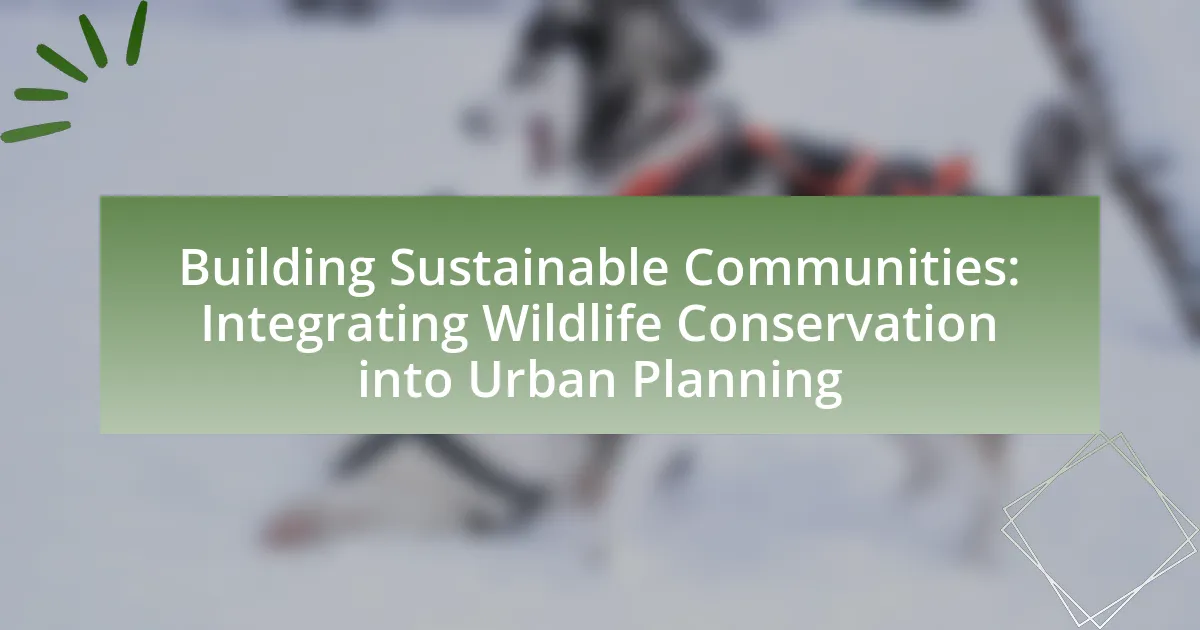Wildlife corridors are critical pathways that connect fragmented habitats, enabling safe animal movement and promoting biodiversity. This article explores the significance of wildlife corridors, detailing their ecological benefits, the challenges faced by species without these connections, and the impact of urban development on wildlife populations. It emphasizes the importance of community engagement in creating effective corridors, outlining strategies for public involvement, the role of local governments and non-profit organizations, and best practices for successful implementation. Additionally, the article discusses methods for assessing the need for corridors, measuring their success, and avoiding common pitfalls in corridor projects.

What are Wildlife Corridors and Why are They Important?
Wildlife corridors are designated areas that connect fragmented habitats, allowing animals to move safely between them. These corridors are crucial for maintaining biodiversity, as they facilitate gene flow among populations, reduce the risk of inbreeding, and enable species to adapt to changing environmental conditions. Research indicates that wildlife corridors can significantly enhance the survival rates of various species by providing safe passage across human-made barriers, such as roads and urban developments. For example, a study published in the journal “Ecological Applications” found that wildlife corridors increased the movement of large mammals by 50%, demonstrating their effectiveness in promoting wildlife connectivity and ecosystem health.
How do Wildlife Corridors benefit ecosystems?
Wildlife corridors benefit ecosystems by facilitating the movement of species between fragmented habitats, which enhances genetic diversity and population stability. These corridors allow animals to access resources such as food, water, and breeding sites, thereby reducing inbreeding and promoting healthier populations. Research indicates that wildlife corridors can increase species richness and abundance; for example, a study published in the journal “Ecological Applications” found that corridors significantly improved the connectivity of habitats for various species, leading to a 30% increase in local biodiversity.
What species are most affected by the lack of corridors?
Species most affected by the lack of corridors include large mammals such as elephants, tigers, and bears, as well as various amphibians and reptiles. These species require extensive habitats and safe passage for migration, breeding, and foraging. The fragmentation of their habitats due to human activities restricts their movement, leading to decreased genetic diversity and increased mortality rates. For instance, studies have shown that elephant populations in Africa face significant challenges in accessing water and food sources due to barriers like roads and urban development, which can lead to human-wildlife conflict and population decline.
How do corridors contribute to biodiversity?
Corridors contribute to biodiversity by facilitating the movement of species between fragmented habitats, which enhances genetic diversity and population stability. These pathways allow animals and plants to access resources, find mates, and adapt to environmental changes, thereby reducing the risks of inbreeding and local extinctions. Research indicates that wildlife corridors can increase species richness by up to 30% in fragmented landscapes, demonstrating their critical role in maintaining ecological balance and resilience.
What challenges do wildlife face without corridors?
Wildlife face significant challenges without corridors, primarily isolation and reduced genetic diversity. When animals cannot move freely between habitats, populations become fragmented, leading to inbreeding and a decline in genetic health. For instance, studies show that isolated populations of species like the Florida panther have suffered from genetic defects due to limited gene flow. Additionally, without corridors, wildlife struggle to access essential resources such as food, water, and mating opportunities, which can lead to increased mortality rates and decreased population resilience. The lack of movement corridors also heightens human-wildlife conflict as animals venture into urban areas in search of resources, further endangering their survival.
How does habitat fragmentation impact wildlife populations?
Habitat fragmentation negatively impacts wildlife populations by isolating species and reducing genetic diversity. When habitats are divided into smaller, disconnected patches, animals face challenges in finding food, mates, and migrating, which can lead to population declines. For instance, a study published in the journal “Ecology Letters” found that fragmented landscapes can reduce the movement of species by up to 75%, significantly affecting their survival and reproduction rates. Additionally, isolated populations are more vulnerable to inbreeding, which can further decrease genetic diversity and resilience against diseases.
What are the consequences of roadways and urban development?
The consequences of roadways and urban development include habitat fragmentation, increased wildlife mortality, and altered ecosystems. Habitat fragmentation occurs when roads divide natural habitats, making it difficult for wildlife to access resources and migrate, which can lead to population declines. Increased wildlife mortality is evident in statistics showing that over one million animals are killed on U.S. roads each day, disrupting local ecosystems. Additionally, urban development often leads to changes in land use that can alter water flow and soil composition, further impacting biodiversity. These consequences highlight the need for effective wildlife corridors to mitigate the negative effects of urbanization on wildlife populations.

How can Communities Engage in Creating Wildlife Corridors?
Communities can engage in creating wildlife corridors by collaborating with local governments, conservation organizations, and landowners to identify critical habitats and develop connectivity plans. This collaboration often involves conducting community workshops to raise awareness about the importance of wildlife corridors, as well as gathering input on potential routes and designs. For instance, the National Wildlife Federation emphasizes the role of community involvement in successful corridor projects, highlighting that local knowledge can significantly enhance planning efforts. Additionally, communities can participate in habitat restoration projects, advocate for policy changes that support wildlife movement, and utilize citizen science initiatives to monitor wildlife populations and corridor effectiveness.
What strategies can communities implement for effective engagement?
Communities can implement strategies such as organizing educational workshops, fostering partnerships with local organizations, and utilizing social media platforms for effective engagement. Educational workshops raise awareness about wildlife corridors and their importance, encouraging community participation. Partnerships with local organizations can enhance resource sharing and broaden outreach efforts, as seen in successful initiatives like the California Wildlife Corridor Project, which engaged multiple stakeholders. Additionally, social media platforms facilitate real-time communication and feedback, allowing communities to mobilize support and share updates efficiently. These strategies collectively enhance community involvement and promote the successful creation of wildlife corridors.
How can local governments facilitate community involvement?
Local governments can facilitate community involvement by implementing inclusive public engagement processes that encourage citizen participation in decision-making. These processes can include hosting community workshops, providing platforms for feedback on local projects, and utilizing social media to reach a broader audience. For instance, a study by the International City/County Management Association found that communities with active engagement strategies saw a 30% increase in public participation in local initiatives. By fostering an environment where residents feel their voices are heard, local governments can enhance collaboration and support for projects like creating wildlife corridors.
What role do non-profit organizations play in community engagement?
Non-profit organizations play a crucial role in community engagement by facilitating collaboration between various stakeholders, including residents, local governments, and businesses. They mobilize community members to participate in initiatives, such as creating wildlife corridors, by raising awareness about environmental issues and promoting sustainable practices. For instance, non-profits often organize workshops, volunteer events, and educational programs that empower individuals to take action in their communities. Research indicates that communities with active non-profit organizations are more likely to engage in conservation efforts, as these organizations provide resources and support that enhance local participation and foster a sense of ownership over environmental projects.
Why is public awareness crucial for wildlife corridor initiatives?
Public awareness is crucial for wildlife corridor initiatives because it fosters community support and participation, which are essential for the successful implementation of these projects. When the public understands the ecological benefits of wildlife corridors, such as promoting biodiversity and reducing wildlife-vehicle collisions, they are more likely to advocate for and engage in conservation efforts. Studies have shown that community involvement can significantly enhance the effectiveness of wildlife corridors; for instance, a report by the World Wildlife Fund highlights that local engagement in corridor planning leads to better outcomes in habitat connectivity and species movement.
How can educational programs raise awareness about wildlife corridors?
Educational programs can raise awareness about wildlife corridors by providing targeted information on their ecological importance and the benefits they offer to biodiversity. These programs can utilize workshops, seminars, and interactive activities to engage communities, illustrating how wildlife corridors facilitate animal movement and genetic diversity. For instance, studies show that wildlife corridors can reduce roadkill incidents by up to 80% when properly implemented, highlighting their role in conservation efforts. By incorporating local case studies and success stories, educational programs can effectively demonstrate the positive impact of wildlife corridors on both ecosystems and human communities, fostering a sense of stewardship and encouraging community involvement in conservation initiatives.
What methods can be used to communicate the importance of corridors to the public?
To communicate the importance of corridors to the public, effective methods include educational campaigns, community workshops, and visual storytelling. Educational campaigns can utilize social media, brochures, and public service announcements to disseminate information about the ecological benefits of wildlife corridors, such as biodiversity preservation and habitat connectivity. Community workshops can engage local residents in discussions and activities that highlight the role of corridors in supporting wildlife and mitigating human-wildlife conflict. Visual storytelling, through infographics and videos, can illustrate the impact of corridors on local ecosystems, making the information more relatable and easier to understand. These methods have been shown to increase public awareness and support for conservation initiatives, as evidenced by successful projects in various regions that have led to enhanced community involvement and funding for wildlife corridor projects.

What are the Best Practices for Implementing Wildlife Corridor Projects?
The best practices for implementing wildlife corridor projects include conducting thorough ecological assessments, engaging local communities, and ensuring connectivity between habitats. Ecological assessments identify critical areas for wildlife movement and help in designing effective corridors. Engaging local communities fosters support and collaboration, which is essential for the success of these projects. Ensuring connectivity between habitats is crucial, as fragmented landscapes can hinder wildlife movement and reduce biodiversity. Research indicates that successful wildlife corridors can significantly enhance species survival rates and ecosystem health, as demonstrated in studies like the one conducted by Beier and Noss (1998), which emphasizes the importance of habitat connectivity for wildlife conservation.
How can communities assess the need for wildlife corridors?
Communities can assess the need for wildlife corridors by conducting ecological assessments and analyzing wildlife movement patterns. These assessments involve collecting data on local wildlife populations, their habitats, and the barriers they face, such as roads or urban development. For instance, studies have shown that areas with fragmented habitats often lead to decreased biodiversity and increased wildlife mortality rates. By utilizing tools like GPS tracking and camera traps, communities can gather concrete evidence of wildlife movement and identify critical areas for connectivity. Additionally, engaging with local stakeholders and experts can provide insights into the ecological significance of potential corridors, ensuring that decisions are based on scientific data and community input.
What tools and resources are available for wildlife corridor planning?
Tools and resources available for wildlife corridor planning include Geographic Information Systems (GIS), wildlife habitat connectivity models, and stakeholder engagement platforms. GIS allows planners to visualize and analyze spatial data related to wildlife movement and habitat distribution, facilitating informed decision-making. Wildlife habitat connectivity models, such as the Connectivity Analysis Tool, help assess potential corridors based on ecological data and species movement patterns. Stakeholder engagement platforms, like the Community Engagement Toolkit, provide resources for involving local communities in the planning process, ensuring that diverse perspectives are considered. These tools collectively enhance the effectiveness of wildlife corridor planning by integrating scientific data with community input.
How can community input shape corridor design and implementation?
Community input can significantly shape corridor design and implementation by ensuring that local needs, preferences, and ecological knowledge are integrated into the planning process. Engaging community members through surveys, workshops, and public meetings allows for the collection of valuable insights regarding wildlife movement patterns, habitat preferences, and potential barriers to wildlife corridors. For instance, a study by the University of California found that community involvement in wildlife corridor planning led to more effective designs that reflected local ecological conditions and increased public support for conservation efforts. This collaborative approach not only enhances the functionality of the corridors but also fosters a sense of ownership and stewardship among community members, ultimately leading to more successful implementation and maintenance of wildlife corridors.
What are the key steps in developing a successful wildlife corridor project?
The key steps in developing a successful wildlife corridor project include identifying critical habitats, engaging stakeholders, conducting ecological assessments, designing the corridor, securing funding, and implementing monitoring strategies. Identifying critical habitats involves mapping areas essential for wildlife movement and survival, which is supported by studies showing that connectivity enhances biodiversity. Engaging stakeholders, including local communities and government agencies, ensures that diverse perspectives are considered, fostering support and collaboration. Conducting ecological assessments helps determine the specific needs of wildlife species, as evidenced by research indicating that tailored approaches increase corridor effectiveness. Designing the corridor requires integrating ecological data with landscape features to create a functional pathway. Securing funding is crucial, often through grants or partnerships, as financial resources are necessary for implementation. Finally, implementing monitoring strategies allows for the assessment of corridor effectiveness and adaptability, with studies demonstrating that ongoing evaluation leads to improved outcomes for wildlife conservation.
How can communities measure the success of their corridor initiatives?
Communities can measure the success of their corridor initiatives by evaluating specific metrics such as biodiversity improvements, wildlife movement patterns, and community engagement levels. For instance, studies have shown that successful wildlife corridors lead to increased species diversity and population stability, which can be quantified through wildlife surveys and monitoring programs. Additionally, tracking the frequency of wildlife sightings and movements through camera traps or GPS collar data provides concrete evidence of corridor effectiveness. Community engagement can be assessed through surveys measuring public awareness and participation in corridor-related activities, with successful initiatives often reporting higher levels of community involvement and support.
What common pitfalls should communities avoid when creating corridors?
Communities should avoid inadequate stakeholder engagement when creating corridors. Failing to involve local residents, landowners, and relevant organizations can lead to misunderstandings, resistance, and ultimately project failure. Research indicates that successful corridor projects, such as the Yellowstone to Yukon Conservation Initiative, emphasize the importance of community input and collaboration, which enhances support and effectiveness. Additionally, neglecting ecological assessments can result in corridors that do not meet wildlife needs, undermining conservation goals. Studies show that corridors designed without thorough ecological planning often fail to facilitate wildlife movement, as seen in various fragmented habitats across North America.
What practical tips can communities follow to enhance their wildlife corridor efforts?
Communities can enhance their wildlife corridor efforts by implementing native vegetation restoration, which supports local wildlife habitats. By planting native species, communities can create a more suitable environment for wildlife, as these plants provide food and shelter. Research indicates that areas with native vegetation support 50% more wildlife than those with non-native plants. Additionally, communities should engage in public education campaigns to raise awareness about the importance of wildlife corridors, fostering community involvement and support. Collaborative efforts with local conservation organizations can also lead to successful corridor planning and maintenance, ensuring that wildlife can safely navigate through urban landscapes.




